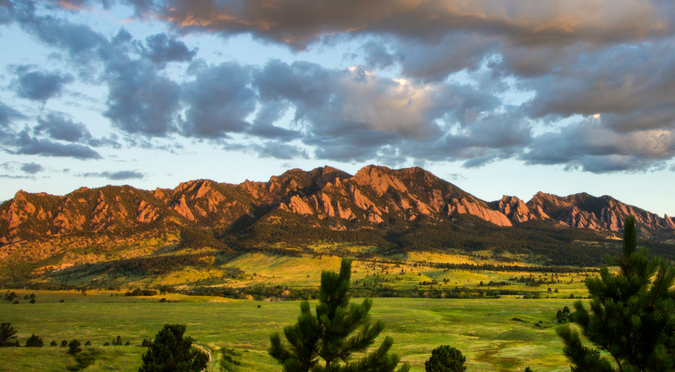Creating a flourishing garden or maintaining a colorful lawn on the Front Range of Colorado can be tricky. With specific soil and irrigation needs, growing plants in Colorado takes a little extra effort than other regions. So, we turned to the experts at the Colorado State University Extension and Outdoor Nursery Manager Alex Tisthammer at Fort Collins Nursery to get the inside scoop on landscaping in Colorado.

If the weather is favorable, outdoor planting of trees, shrubs and perennials can begin as soon as mid-April if the plants have been hardened off, or gradually exposed to wind and temperature fluctuations. Planting for frost-tender annuals and garden veggies can begin at the end of May or the first week of June. This is when we’re most likely to be done with spring snowstorms, and the ground is warm enough to help seeds germinate and young seedlings flourish. If you’re antsy to get your fingers into soil, start seeds indoors now, then transplant the seedlings outside when weather reports indicate there’s no longer a danger of an evening frost.
Tips for vegetable gardens
If you dream of tending a backyard veggie patch, the first step is to get your soil quality tested. (The CSU Extension office can do this for you.) This test allows you to see if you need to add any organic supplements such as compost or pea-size gravel to your garden beds.
Many housing divisions in the Front Range have compacted clay soil that’s difficult for roots to penetrate. The way to solve this problem is by opting for a raised garden bed filled with a mixture of soil and pea gravel from a nursery, or by tilling soil into several inches of your ground-level garden beds. Raised beds are also a good option for those who prefer to garden from a standing position or want to keep pets and tiny tots away from fragile seedlings.

Watering in Colorado
To ensure your garden and landscaping features get enough moisture, it’s best to install a drip system or plan a daily hand-watering schedule. As the plants mature, they become more resilient to our climate and need less daily attention.
When adding a new plant to the garden, check it daily for the first week. Place your finger at least two inches into the soil and see if it feels moist. If not, the plant needs water. Note how often the plant seems to need water, then adjust your watering schedule.
Choosing your plants
Once you have ideal soil, drainage and watering in place, it’s time to stock up on seed packets or seedlings from a garden center. On the Colorado Front Range, you want to choose vegetables that take fewer days to mature and harvest.
Tisthammer says greens like spinach and lettuces as well as baby carrots, beets, radishes, baby bell peppers and cherry tomatoes are perfect for Colorado gardens.
Tips for Larimer County landscaping
If you’re hoping to fill decorative pots to flank your front door or update the landscape design around the perimeter of your property to create year-round interest, choose perennials. They will need regular watering for the first season, then Mother Nature can take over. However, some plants positioned close to your home or garage may need additional watering if they’re blocked from the rain. Perennials return to their full beauty after the snow melts and only require pruning and trimming to maintain a coiffed appeal.
Plants for potting

Our planting zone is 5. Keep an eye on the ratings of the plants you’re choosing, or ask a garden nursery attendant for assistance. If you’re planting in containers, go with a colder zone rating, such as 3, for success. Then, choose bigger-than-usual pots filled with warm, insulating soil to keep those roots cozy. A few plants to explore include hens and chicks, columbines, echinacea, succulents and evergreens. Love bulbs like daffodils and tulips? They can be planted in pots, but are better suited for garden beds and ground planting.
Native trees and shrubs

If you’re in building mode or starting with a fresh, open yard, consider adding native and locally popular species to your property. They’re used to our high-pH, clay-rich soil. The following trees do well as long as they are watered regularly for their first season and saplings are fitted with tree wrap to protect them from winter winds from November through late-March.
- Austrian Pine
- Cottonwoods (Lanceleaf, Plains, Narrowleaf) – Check HOA and area ordinances as Cottonwoods are sometimes prohibited.
- Crab Apples
- Hawthorn
- Mountain Ash
- Ponderosa Pine
- Rocky Mountain Juniper
If you’re looking for shrubs to create a hedge, privacy wall or natural fencing around your land, be sure you have excellent drainage by way of a sand or rock layer in your soil. Some of the best plants to consider in Larimer County include:
- Apache Plume
- Crandall Clove Currant (Yes, they are edible!)
- Fernbush (Desert Sweet)
- Leadplant (This is a great substitution for Russian Sage)
- Mockorange (This has a heavenly orange blossom scent)
- Mountain Mahogany (They have decorative ornamental seed heads)
- Rabbitbrush
- Sumac (Tall and short)
- Tall Western Sage (Artemesias)
- Wild Rose (The rose hips can be used medicinally)
- Winterfat
Pretty Perennials
Are cacti, grasses and flowers your preference? There are several varieties that flourish on the Front Range. Whether you’re designing your gardens on your own, or working with a landscaper, add these Colorado-loving plants to your consideration list.
Cacti:

- Mammillaria or Nipple Cactus (Yellow and Pink)
- Plains Yucca
- Prickly Pear
Grasses:

- Big Blue-stem
- Blue Grama (Blonde Ambition)
- Mountain Muhly (This is related to Undaunted Ruby Muhly)
- Prairie Dropseed Grass
- Switchgrass
Flowers:

- Bee Balm
- Blanketflower
- Blue Flax
- Chocolate Flower (This has a delightful fragrance)
- Desert Four O’Clock
- Goldenrod
- Liatris
- Milkweed
- Pasque Flower
- Penstemon
- Prairie Smoke Geum
- Purple Coneflower
- Pussytoes
- Rocky Mountain Columbine (This is our state flower!)
- Scarlet Globemallow
- Yarrow
Using home equity for landscaping

Adding beauty and value to your home can be a smart investment. Whether you plant a few trees, build raised garden beds or line the walk with a variety of perennials, you’re sure to enhance your outdoor living space.
You can use the equity in your home to purchase landscaping supplies and services with a Home Equity Loan or Line of Credit*. At Elevations, our lending team cares about you, your story, and finding the best solution to meet your goals. We have a variety of term options, and fixed and variable rates that often save you money compared to a credit card or other loan. Plus, there’s no application fee!
Use this calculator to see how much equity you may have available in your home.
Are you ready to tackle a yard makeover? You’ll not only enjoy the beauty of your manicured property, but you may also be able to boost your home’s value and initiate buyer interest if you’re planning on selling soon. Learn more about a home equity loan here, or give us a call at 800.429.7626.
*Offers of credit are subject to credit approval and underwriting. Financing only available on Colorado properties. Equal Housing Opportunity Lender NMLS 717246.
Additional Sources: Colorado State University Extension


